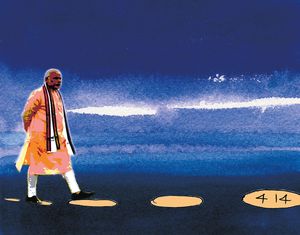There is one electoral record that Narendra Modi wants to equal in 2024; there is another he aspires to break. Both are currently held by the Nehru-Gandhis.
The first is of Jawaharlal Nehru—to win three general elections in a row. Nehru led his Congress to victory in 1952, 1957 and 1962. Modi and his partymen, who won in 2014 and 2019, are pretty sure of equalling the feat in 2024. The BJP’s wins in the three assembly polls of the last one month have boosted their confidence.
The other record is held by Rajiv Gandhi; that looks harder to equal or to break. The Mr Clean of Indian politics won only one general election, but in that one he won 414 seats, the highest number ever won by any single party or alliance. Of course, as a commentator wrote a bit uncharitably at that time, Rajiv didn’t win the votes; his dead mother won them for him.
To borrow a line from a 1976 Dickey Lee song, “nine million, nine hundred and ninety-nine thousand, nine hundred ninety-nine tears” shed over the assassination of Indira Gandhi spawned several million more votes. In the end, every second voter in India stamped on the hand—the only time when a party got nearly half the votes polled.
Converting tears into votes is no big deal. The tougher task is to convert the mandate of tears into a mandate for good governance, and get it endorsed in the next round. That’s where Rajiv failed. He wasted away his mandate in five years, and got voted out.
Modi never traded tears for votes. His opponents say, he has traded fears for votes. They say, he banked on several fears, imagined or otherwise, to garner votes—fears about neighbours, fears about minorities, and fears about ‘the other’.
Maybe so. But Modi’s success has been that he converted the mandate of fears into a mandate for “a government that worked”, to borrow Indira’s slogan of 1979-80. That stood him in good stead in the second round when he bagged 303 for the BJP and 353 for the NDA. Now he hopes to improve on those for a Modi-3.0.
Easily wished than won, even with last week’s surprise wins in three heartland states and a better show in Telangana. Let’s get to the brasstacks. The three states that favoured the BJP in the recent assembly round had already given all or nearly all their Lok Sabha seats to Modi-2.0. Despite having voted the Congress to the assembly in 2018, Madhya Pradesh gave 28 of its 29 seats to Modi in 2019, Chhattisgarh 9 of 11, and Rajasthan 24 of 25. Simply put, these three states can’t give more for Modi-3.0 in 2024.
If he has to improve from the 303 and 353, Modi will have to conquer more of the coasts. The Saurashtra and the Konkan coasts are already his or easy picks. The Bengal, the Kalinga, the Carnatic, the Coromandal and the Malabar coasts are still eluding him, as Asoka found before he marched to Kalinga, and established pax Mauryana.
In military battles, the terrain and technology dictate the tactics. In political battles, the times and the tide do. If the run-up to Modi-1.0 and Modi-2.0 were about exorcising the ghosts of the Ghaznis and the Ghoris, about showing a 56-inch chest to Pakistan, and about taking on or trading with the Chinese dragon, Modi-3.0 looks like more about his claims to statesmanship after hosting the G-20, about engaging the world leaders with a Nehruvian ease and felicity, about building a viksit Bharat or developed India by 2047.
If the Indian National Congress imparted the idea of India in the 20th century, Modi wants the Bharatiya Janata Party to impart a bhavna of Bharat in the 21st century.
How can INDIA counter it?
prasannan@theweek.in


